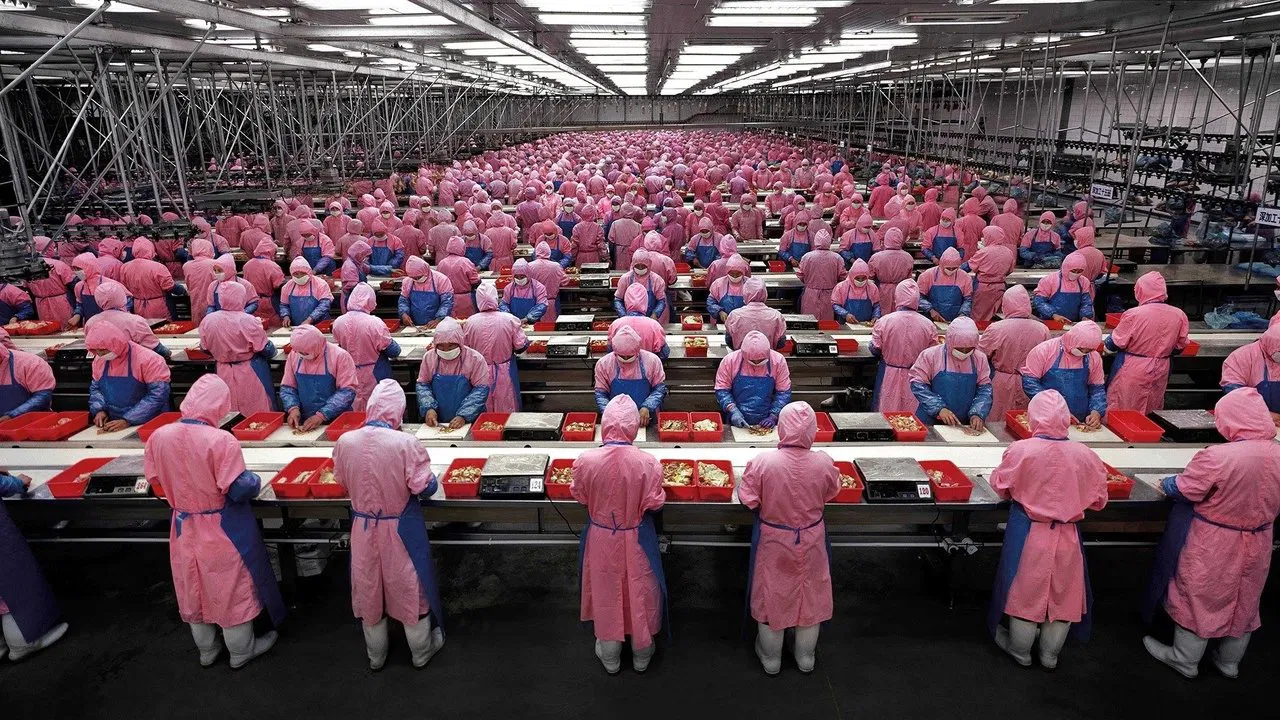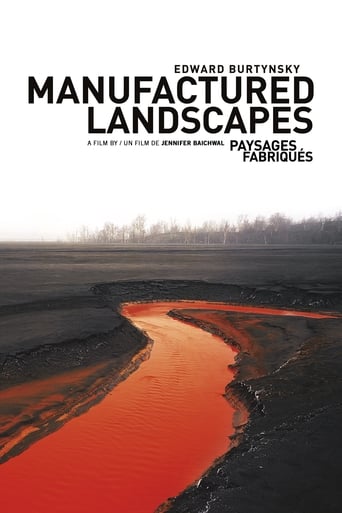

Watching this in 2016 i realized that the industrious images shown in this documentary are ten years old. All the people you see have gone somewhere, developed, aged, some died. They are all shown as tiny cogs in this man-made machine that's called industrialization, mostly seen in the specific context of China, early 21st century. You see them doing monotonous work in the most efficient way, Marx' nightmare, barren landscapes ravaged by pollution, cities being destroyed for a new dam.It's a sombre portrait that doesn't forget the human factor. The shot of a lone man in a giant factory sleeping at his workbench after everybody left is typical, sad and beautiful at once. These and other images made me emotional, without being forced to feel that way. The film tells you that the scope and character of what you are seeing is unprecedented in history. It has an eye for the innate bizarre-ity of the shapes created in industrialization, captured in beautiful photographs that regularly show up. There is commentary, yet sparsely, a loose narrative of the films' creative process and some musing about the way how we as humankind transform nature. It's an intellectual take on industrialization, instead of immediately jumping to condemnation. Pessimism still prevails though, and by witnessing what the filmmakers witnessed it's hard to disagree with them. The music was the only thing that disrupted my attention at times. It's a dark form of Ambient that can be too present in wanting you to feel depressed about what was being shown. It's not needed, the sounds of the locations themselves are interesting enough by themselves.
... View MoreThis felt a little like a companion piece to Wall-E briefly in the beginning; images of overwhelming waste, even nice compacted cubes of it a la that film. Then later it sort of connected for me with a book I recently read called "Lost on Planet China" by J. Maarten Troost, although that book wants to be a comedic monologue more than a travelogue/social commentary.This film is humorless. Which is fine, but the notion that it is not a polemic, or even the photos alone are not political, is quite unfair, even if I do tend to lean the same way as the filmmaker's viewpoint. I understand that some people feel China is one huge Pittsburgh/Sheffield and that "we" are defiling our Mother Earth. I'm not entirely sure I buy that though.I'm always a little suspicious of "the old ways are best" thinking. I'm generally pretty happy with increasing life-spans, and I know that change comes with costs. Ideally you minimize the damage, but I wondered how these filmmakers would depict the birth of a child. Notice the woman's body beforehand, but now in manufacturing a child, look at the gross distension of the innards, and once the child is finally delivered, observe the impact on the once-vibrant young couple as they struggle through endless hours of sleeplessness and toil with the mound of waste produced by just one child.For some reason, I also expected the photography to be more artistic, a la "The War Photographer" (a film that I would recommend if you liked this one, or even if you just finished this one). I liked one of the Chinese people, examining a picture of him and remarking how the scale of the shot was so large that there was no detail. Nothing intimate.Anyways, an interesting albeit strongly biased view of China...just the number of women workers in different positions was fascinating. Including the "Lifestyles of the Rich and Famous" with the either attractive or repelling (or both for me?) Diana Lu, extravagant real estate agent, was kind of weird to me. Especially when contrasted with omitting the stonecutter, who was in the deleted scenes, well all choices are loaded.I'll look for the photography book at the library, some of those shots with a green oval inside a strip mining pit show briefly in the film I wanted to understand more. I assume enhanced via filters/processing. Also the Bangladesh ship graveyard...while maybe meant to be a cautionary scaring about our wasteful ways was nonetheless compelling, like having a ringside seat to the La Brea Tar Pits back when the dinosaurs were laying down for extinction.The legacy of China's rapid growth will be understood long after I am gone, and I'm not so sure that Eve and Wall-E will be weeping over the Great Wall crumbled down to build our great-great-great automaton grandchildren.
... View MoreThe movie opens up with a long single shot of aisles in factory crammed with workers. My, what we've done to the planet you might think. I hope we get to see other things like this.That's very rare. When you're not looking at a horribly filmed angle of the narrator at a lecture hall, you're watching him set up his camera to take pictures in different locations. It'd be nice if chose areas that were more fitting with his topic but he doesn't. So, then you'll hear some more narration, watch a few pictures go by and watch him set up his camera. Why not use the filming camera to show more of the landscapes instead? It really kills any sense of pacing and paints the guy as more of vain jerk.I could read tips on how someone set up their camera, fast forward through this whole movie and waste a lot less time.
... View MoreReviewed at the World Premiere screening Sept. 9, 2006 at the Isabel Bader Theatre during the Toronto International Film Festival (TIFF).This had an interesting premise but seemed to go on too long with too many shots of piles of eWaste (recycled computers, keyboards, cables etc. shipped over to China by the ton and then sorted and remade into new products to sell back) and other desolation.The filmmakers tried to get more people interviews to boost the human element but were frequently prevented from doing so due to Chinese censorship. Still, what was there was interesting. The bits of a Shanghai high end real estate agent preening and strutting around showing off her luxurious mansion and gardens, intercut with the scenes of others living in medieval conditions were especially striking. The opening tracking shot of a 480m factory floor was quite something as well. Scenes of the activity at the Three Gorges Dam project were also a complement to the Jia Khang-je films at TIFF (the feature Still Life/Sanxia Haoren & the documentary Dong) which were also built around that subject.Director Jennifer Baichwal, Producer Nick de Pencier, Cinematographer Peter Mettler and subject Edward Burtynsky were all there on stage for a Q&A after the world premiere. Producer Noah Weinzweig was introduced from the audience and was thanked as the most key person that assisted in the on the ground access in China itself.
... View More